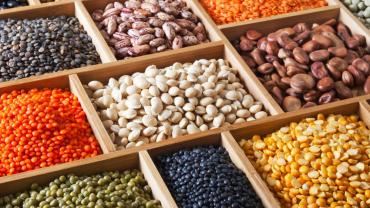
Beans and legumes (also known as pulses) present an enigma to health advocates and nutritionists in the wake of the Paleolithic lifestyle. Paleo loyalists refuse to partake in these starchy pods but others argue for their undisputable nutrition. Beans and legumes offer our gut microbiota a source of prebiotic fiber deliver various minerals and are a source of plant-based protein. However they contain antinutrients and have copious amounts of starch that can create gaseous byproducts and trigger bloating abdominal distention and pain.
So what’s the answer? While some may still permanently eliminate this food group it seems there is a way around the acclaimed antinutrients and even the heavy starch content making this an acceptable food choice for some. That’s right. Research tells us the method of preparing beans and legumes is the key to their nutritive value.
Antinutrients
Antinutrients include compounds such as lectins enzymes inhibitors and phytates which can hinder the digestion and absorption of certain vitamins minerals and nutrients and exert some toxic effects on the gastrointestinal tract. Lectins are sugar-binding proteins that can increase intestinal permeability and may cause acute gastroenteritis. Phytates (or phytic acid) can bind zinc iron and other minerals rendering them unavailable to the body and contributing to deficiencies. Phytates form complexes that increase soluble oxalates and can increase the risk of kidney stone development in predisposed individuals. Finally phytates inhibit enzymes required to break down proteins and starch which can be problematic for people with leaky gut or other gastrointestinal disorders. The problem with pointing the finger at beans and legumes is that many other foods such as spinach Swiss chard nuts seeds and cacao also contain notable levels of phytic acid and lectins.
Health Benefits of Beans and Legumes
On the other side of the fence beans and legumes are sources of potassium magnesium folate iron zinc some antioxidants and an impressive amount of amino acids. In fact they are one of the few plant-based sources of the amino acid lysine which makes beans and legumes an extremely important component of a vegan diet.
The fiber (and the lectins) also bind glucose delaying its absorption and improving glycemic control. Numerous studies have shown the inclusion of beans and legumes to be beneficial in the management of diabetes. The copious amounts of fiber in this food group has also proven to be profitable for weight loss due to its effects on blood sugar and satiety. Finally the fiber potassium and blood sugar regulating effects of beans and legumes have been shown to significantly reduce blood pressure decreasing risks for cardiovascular disease. Certainly beans and legumes confer some significant health benefits.
Soaking Cooking Fermenting and Sprouting
The preparation beans and legumes seems to be an important factor in reducing their negative aspects while enhancing their nutrition. Soaking cooking sprouting and fermenting may be the keys to enjoying beans and legumes.
Soaking beans and legumes before cooking them begins to break down the oligosaccharides that could be responsible for producing excess gas. This starch is responsible for removing beans and legumes from the FODMAP diet and making them intolerable for those with IBS or SIBO. Soaking also reduces the phytate concentration by 20 to 30 percent. Therefore soaking can enhance the nutrient bioavailability and reduce fermentable starch molecules.
Both phytates and lectins are resistant to heat but cooking moderately neutralizes lectins. The higher the heat or pressure applied during the cooking process the greater the neutralization of lectins. Pressure cooking confers the best outcome. Phytates on the other hand are not reduced by cooking. This makes soaking before cooking an important step.
Fermentation is an extra step that has been shown to reduce phytates by up to 90 percent resulting in much greater mineral availability. Microbes that naturally exist during fermentation have enzymes that can break down phytates and they generate an optimal pH to enhance enzymatic degradation of phytates. Furthermore fermenting microbes release organic acids (i.e. citric malic lactic acid) that impart various health benefits and enhances the body’s ability to absorb minerals.
Sprouting (or germination) is another method of preparation that has been shown to increase the nutritional value of beans and legumes. Sprouting can significantly reduce starch and increase the availability of the amino acids through proteolytic cleavage. Antioxidant and phytonutrient levels increase during sprouting. Several phenolic compounds and organic acids are increased after sprouting and bestow various medicinal benefits.
Optimizing the health of beans and legumes may be as easy as preparing them correctly. If soaking and sprouting can eliminate the fermentable starches while cooking and fermenting removes the phytates then the result should be an easily digestible source of amino acids fiber minerals and phytonutrients. Sprouting especially has been claimed to be the ticket to painless pulses.